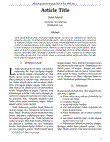Resultados de búsqueda - "latín"
Materias dentro de su búsqueda.
Materias dentro de su búsqueda.
- Latin America 18
- América Latina 13
- Latinoamérica 7
- Mexico 4
- México 4
- gender 4
- género 4
- Democracia 3
- Democracy 3
- O54 3
- democracia 3
- democracy 3
- doblaje 3
- dubbing 3
- estudiantes 3
- política 3
- redes sociales 3
- 2
- Boom Latinoamericano 2
- Brasil 2
- Brazil 2
- China 2
- Confianza 2
- Criminal Law 2
- Derechos humanos 2
- E24 2
- Economy 2
- Ecuador 2
- European Union 2
- Gobierno local 2
-
321
-
322
-
323
-
324
La metrópoli prematura contemporánea en la metamorfosis urbana como un proceso evolutivo ad perpetuam
Publicado 2022“… [1] La intención de utilizar este metodología particular que induce al razonamiento deductivo, consiste en tener la posibilidad de avanzar en el conocimiento sobre estos espacios sui géneris llamados zonas metropolitanas; esto, a partir de la definición del concepto de metrópoli prematura, el cual será integrado al análisis metropolitano con la finalidad de visualizar desde la perspectiva de prematurez, la manera característica en que tienden a consolidarse territorialmente las zonas metropolitanas en México.. [2] El concepto de Alteridad (del latín alter: el Otro de entre dos términos, considerado desde la posición del uno, esto es, del Yo) es el principio filosófico de alternar o cambiar la propia perspectiva, por la del Otro, considerando y teniendo en cuenta el punto de vista, la concepción del mundo, los intereses, la ideología del Otro; no dando por supuesto que la de uno es la única posible. …”
Enlace del recurso
Artículo -
325
-
326
-
327
-
328
-
329
-
330
-
331
-
332
-
333
-
334
El Agua: Pilar Fundamental para la Sostenibilidad del Futuro
Publicado 2024Enlace del recurso
Artículo -
335
Transcultural analysis of the digital environment for managing learning in university students
Publicado 2024“…Research Implications: This study contributes to understanding the digital divide in learning scenarios and the processes of incorporating ICT in higher education in two Latin American countries. Originality/Value: The relevance of this research lies in presenting the differential impact of digital divides in terms of accessibility, connectivity, and the use of digital technology in learning environments. …”
Enlace del recurso
Artículo -
336
CAMBIOS EN LAS VARIABLES DE RIESGO CARDIOVASCULAR EN UNA COHORTE DE ESTUDIANTES UNIVERSITARIOS DE LA CIUDAD DE MÉXICO
Publicado 2011“…Given that there are scarce cohort studies in -Latin America regarding cardiovascular risk factors, particularly in young population groups, the purpose of the this study was to follow up the behaviour of cardiovascular variables during a period of three and a half years. …”
Enlace del recurso
Artículo -
337
SALUD BUCAL Y HÁBITOS ALIMENTARIOS EN ESTUDIANTES UNIVERSITARIOS
Publicado 2010“…In reference to studies made in similar populations in Latin America and Spain, shows that our results confirm the it is observed that our results confirm the assertions made evident by these to indicate a significant association between dietary habits and DMFT and OHI-S. …”
Enlace del recurso
Artículo -
338
LA DIETA Y SU IMPORTANCIA EN LA CARIES DENTAL
Publicado 2012“…We observed a similar behavior of the indices calculated in this population and results in Latin America. By another side, we observed that there is no difference between the studied indices of oral health between genders. …”
Enlace del recurso
Artículo -
339
Population growth and its implications (Crecimiento poblacional y sus implicaciones)
Publicado 2005“…Most of that growth will occur in the less developed countries of Asia, Africa, and Latin America. There is a serious concern that the number of humans in the world and our impact on the environment will overload the life support systems of the earth. …”
Enlace del recurso
Artículo -
340
Estudio de datos normativos de tres pruebas neuropsicológicas en población adulta de Mexicali, Baja California
Publicado 2021“…This work is part of a multicenter study in which 5,402 adults were evaluated in 20 cities of 12 Latin American countries. An explanatory correlational design was used and the participants were assigned to different groups depending on their sex, age and education; once they met the inclusion criteria. …”
Enlace del recurso
Tesis

